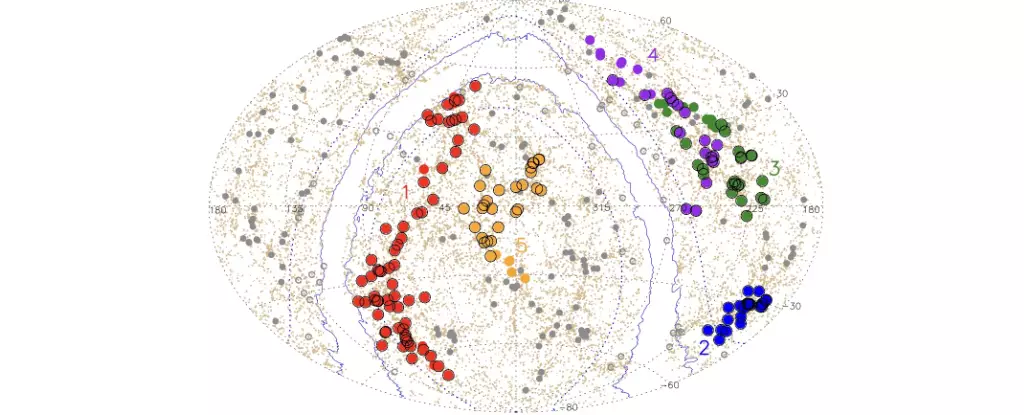To truly comprehend the complexities of the Universe, a profound understanding of its largest structures is not just beneficial; it is essential. The Universe is a vast, dynamic entity, with colossal formations that not only house groups of galaxies but fundamentally influence our perceptions of cosmic phenomena. One of the most significant discoveries in this realm is the Quipu superstructure, a remarkable entity that challenges our conventional understanding of astronomical phenomena. With a mass equivalent to 200 quadrillion solar masses and a staggering length of over 400 megaparsecs (approximately 1.3 billion light-years), Quipu serves as a critical focal point for astronomers aiming to decode the mysteries of cosmic evolution.
Named after the Incan recording device made of knotted cords, Quipu symbolizes the intricate web of interaction between celestial bodies. The sheer scale of this superstructure gives insight into the nature of cosmic organization. Quipu alone is said to encompass roughly 45 percent of all galaxy clusters and 30 percent of known galaxies within a specific volume. Its immense gravitational influence affects neighboring structures and plays a crucial role in the cosmic web—a vast network that connects galaxies through gravitational interactions. These superstructures are vital for understanding phenomena such as galaxy evolution and the distribution of dark matter in the Universe.
Understanding Quipu’s impact on cosmological measurements is vital. According to recent research led by Hans Bohringer of the Max Planck Institute, the presence of such superstructures significantly influences critical cosmological parameters. For accurate interpretations of observations, astronomers must consider factors like the Cosmic Microwave Background (CMB)—the radiation leftover from the Big Bang. Superstructures like Quipu create distortions in the CMB due to their immense mass, resulting in various fluctuations that complicate our understanding of the Universe’s early history.
The Integrated Sachs-Wolfe (ISW) effect, for example, highlights how gravity from superstructures alters the paths of photons coming from the CMB. These distortions can create foreground noise, which poses a challenge for astronomers seeking precise measurements. Likewise, these superstructures affect the Hubble constant, a key parameter that denotes the rate of the Universe’s expansion. The interplay between the large-scale gravitational forces exerted by massive structures and the local peculiar velocities of galaxies complicates our measurements, necessitating a more nuanced approach to cosmological data.
The analysis of Quipu and its fellow superstructures was achieved through the Cosmic Large-Scale Structure in X-rays (CLASSIX) Cluster Survey, which examines X-ray emissions from galaxy clusters. This method is pivotal, as X-ray emissions reveal dense regions within the cosmic web, marking out the positions of superstructures like Quipu. The data collected from X-ray observations provides crucial insight into the mass distribution within these cosmic formations, paving the way for better models of how galaxies and clusters evolve over time.
Notably, researchers have observed significant differences in the density of galaxy clusters within superstructures compared to isolated field clusters. This revelation signifies that larger, more massive structures likely host a higher concentration of galaxies, directly influencing evolutionary pathways in ways previously not accounted for in cosmological models.
While superstructures like Quipu currently play an influential role in our cosmological understanding, researchers caution that these colossal formations are not permanent fixtures. The evolutionary trajectory of the Universe suggests that, over time, superstructures will fragment and reorganize into smaller clusters. Future research could delve into the transient nature of these structures and their implications for galaxy formation and evolution.
Moreover, investigating the effects these superstructures have on galaxy populations will enhance our understanding of cosmic dynamics and help refine our cosmological models. As hinted by the research, more extensive studies examining how galactic environments influenced by superstructures facilitate or hinder galaxy evolution will be crucial.
Understanding vast cosmic structures like Quipu is paramount for advancing our grasp of the Universe. These enormous entities not only serve as repositories for a significant fraction of the Universe’s mass but also shape the gravitational landscape governing cosmic dynamics. Enhanced observational techniques and refined analytical frameworks will be essential for unraveling the mysteries embedded within these immense formations. The quest to comprehend the Universe’s intricate design continues, and with it, the promise of new discoveries that could redefine our cosmic narrative.


Leave a Reply